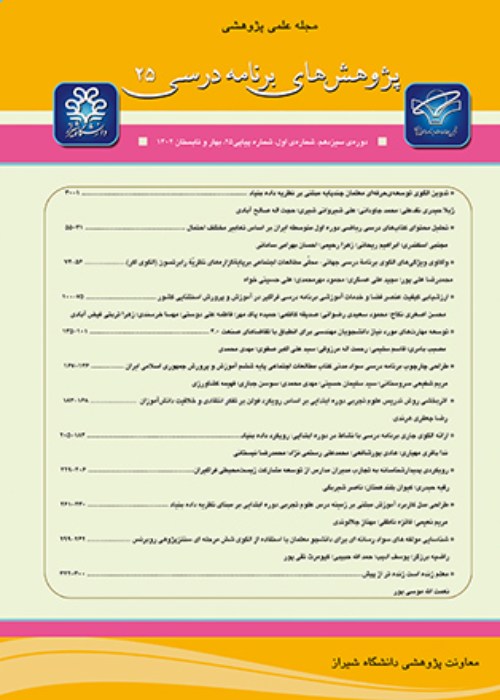Investigating the Effectiveness of Teaching Elementary Experimental Sciences Based on Michael Fullan’s Approach to Students’ Critical Thinking and Creativity
The most important period in all education systems in the world is the primary level, so studying different dimensions in this stage of education, especially the teaching method, is of great importance. An effective teaching method can facilitate deep learning, which can be achieved by a continuous and close review of teaching methods. ‘Experimental sciences’ is one of the subjects taught in Iran in primary school; thus, what teaching method(s) should be used to teach this course effectively deserves attention. In an attempt to deal with the factors causing students’ poor performance in ‘experimental sciences’, researchers have suggested that teaching methods that are based on students’ deep learning can be the solution. In addition, they believe that deep-learning-based curricula can influence students’ views on how to learn experimental sciences by promoting creativity and critical thinking. Therefore, considering the centrality of deep learning in Michael Fullan’s approach and the emphasis of many researchers in the field of experimental sciences education on deep learning, the present study was designed to, first, identify the curriculum components related to goals, content, teaching-learning strategies, evaluation, grouping, required resources and facilities, time, and place with the main goal of promoting deep learning in the form of the four levels introduced by Fullan. To this end, the challenges and needs associated with the teaching methods of ‘experimental sciences’ were determined by reviewing the existing literature. In this study, for the first time, a method of teaching ‘experimental sciences’ in primary school was developed based on Fullan’s approach. Afterward, the validity of the developed teaching method and its effectiveness on students’ critical thinking and creativity were investigated
Research questions:
The present study was aimed at answering the following questions:1- Is the teaching method developed based on Fullan’s for teaching ‘experimental sciences’ in primary school theory effective in improving students’ critical thinking?
2- Is the teaching method developed based on Fullan’s theory for teaching ‘experimental sciences’ in primary school effective in improving students’ creativity?
The present study utilized a semi-experimental design with a pre-test, post-test control group. The statistical population of the study included all male primary students in Isfahan, Iran, in the academic year 2014-2016. First, a male school from one of the six education districts in Isfahan was selected using convenient sampling. This limited sampling was done to control the social and cultural characteristics of students, school conditions, and non-participation in ‘experimental sciences’ deep reinforcement learning. Then, consent was obtained from the school principal, and the objectives of the research were fully explained to him. Finally, two third-grade primary classes, each with 25 students, were selected randomly as the study sample. Of these two classes, one class was randomly selected as the experimental group and the other as the control group. The students were asked to complete the Critical Thinking Questionnaire (CTQ) and the Torrance Tests of Creativity Thinking (TTCT). Then, the experimental group was taught ‘experimental sciences’ based on Fullan’s approach for four months (half of the academic year) while the control group received conventional education. It should be mentioned that it was the first time that a teaching method was developed for primary ‘experimental sciences’ based on Fullan’s theory. The new teaching method was developed to address the deficiencies and shortcomings of the existing teaching methods. Before applying the newly developed teaching method, the teacher in charge of the classes was fully instructed and guided on how to use the aforesaid method. The components of the developed teaching method were identified with the cooperation of the teacher, who was encouraged to apply all the aspects of the developed method in his/her teaching. Finally, after the method was used to teach the students in the experimental group for half of an academic year, the post-examination was given to students. Data analysis was done by ANOVA using SPSS software.
The results of a comparison of pre-test and post-test scores for both groups revealed that the effect of teaching ‘experimental sciences’ based on Fullan’s approach to critical thinking and creativity was significant and that the newly developed teaching method improved the critical thinking and creativity of students in the experimental group. The correlation coefficients showed that the 35.1% and 22.7% differences in critical thinking and creativity, respectively, between the control group and experimental group were caused by the new teaching method of primary ‘experimental sciences’ developed based on Fullan’s theory.
Therefore, it can be stated that a teaching method developed based on Fullan’s approach can be effective in teaching ‘experimental sciences’ in primary school.
- حق عضویت دریافتی صرف حمایت از نشریات عضو و نگهداری، تکمیل و توسعه مگیران میشود.
- پرداخت حق اشتراک و دانلود مقالات اجازه بازنشر آن در سایر رسانههای چاپی و دیجیتال را به کاربر نمیدهد.


